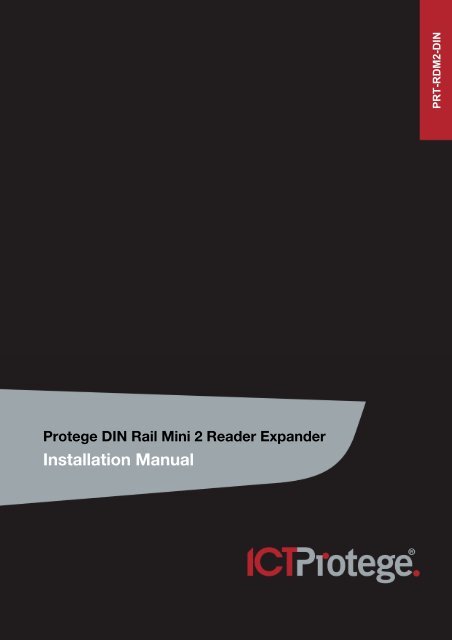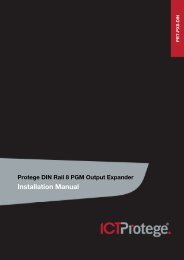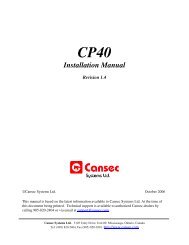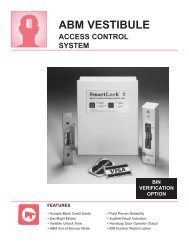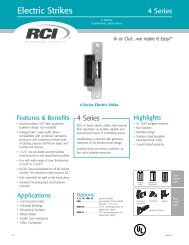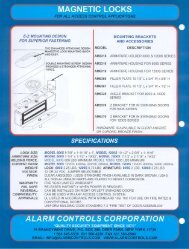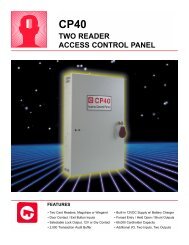Protege DIN Rail Mini 2 Reader Expander
Protege DIN Rail Mini 2 Reader Expander
Protege DIN Rail Mini 2 Reader Expander
You also want an ePaper? Increase the reach of your titles
YUMPU automatically turns print PDFs into web optimized ePapers that Google loves.
PRT-RDM2-<strong>DIN</strong><br />
<strong>Protege</strong> <strong>DIN</strong> <strong>Rail</strong> <strong>Mini</strong> 2 <strong>Reader</strong> <strong>Expander</strong><br />
Installation Manual
The specifications and descriptions of products and services contained in this document were correct at the time<br />
of printing. Integrated Control Technology Limited reserves the right to change specifications or withdraw<br />
products without notice. No part of this document may be reproduced, photocopied, or transmitted in any form<br />
or by any means (electronic or mechanical), for any purpose, without the express written permission of Integrated<br />
Control Technology Limited. Designed and manufactured by Integrated Control Technology Limited. <strong>Protege</strong>®<br />
and the <strong>Protege</strong>® Logo are registered trademarks of Integrated Control Technology Limited. All other brand or<br />
product names are trademarks or registered trademarks of their respective holders.<br />
Copyright © Integrated Control Technology Limited 2003-2011. All rights reserved.<br />
Publication Date: November 2011<br />
2 PRT-RDM2-<strong>DIN</strong> <strong>Protege</strong> <strong>DIN</strong> <strong>Rail</strong> <strong>Mini</strong> 2 <strong>Reader</strong> <strong>Expander</strong> Installation Manual | November 2011
Contents<br />
1 Welcome _________________________________________________________________ 4<br />
1.1 Document Conventions ................................................................................................. 5<br />
2 Mounting _________________________________________________________________ 6<br />
2.1 Enclosure Removal ........................................................................................................ 6<br />
3 DC Power and Encrypted Module Network ___________________________________ 7<br />
4 Door Access Control _______________________________________________________ 8<br />
4.1 <strong>Reader</strong> Connection ........................................................................................................ 8<br />
4.2 Multiple Wiegand <strong>Reader</strong> Connection ........................................................................... 9<br />
4.3 Magnetic <strong>Reader</strong> Connection ...................................................................................... 10<br />
4.4 Door Contact Connection ........................................................................................... 10<br />
4.5 Door Lock Connection ................................................................................................ 11<br />
5 Zone Inputs ______________________________________________________________ 12<br />
5.1 Trouble Zone Inputs .................................................................................................... 13<br />
6 Programmable Outputs ___________________________________________________ 14<br />
6.1 Lock PGM Outputs (1 and 2) ....................................................................................... 14<br />
6.2 Standard PGM Outputs (3 To 8) .................................................................................. 15<br />
6.3 PGM Beeper Outputs Special Function (5 and 8) ....................................................... 16<br />
7 Address Configuration ____________________________________________________ 17<br />
8 LED Indicators ___________________________________________________________ 18<br />
8.1 Status Indicator ........................................................................................................... 18<br />
8.2 Fault Indicator .............................................................................................................. 18<br />
8.3 Power Indicator ........................................................................................................... 19<br />
8.4 Relay 1/Relay 2 Indicators ........................................................................................... 19<br />
8.5 <strong>Reader</strong> 1/<strong>Reader</strong> 2 Indicators ..................................................................................... 19<br />
9 Error Code Indication _____________________________________________________ 20<br />
9.1 Error Code Display ...................................................................................................... 20<br />
10 Mechanical Diagram ______________________________________________________ 21<br />
11 Mechanical Layout _______________________________________________________ 22<br />
12 Technical Specifications ___________________________________________________ 23<br />
13 Ordering Information ______________________________________________________ 24<br />
14 Warranty ________________________________________________________________ 25<br />
15 Contact _________________________________________________________________ 26<br />
PRT-RDM2-<strong>DIN</strong> <strong>Protege</strong> <strong>DIN</strong> <strong>Rail</strong> <strong>Mini</strong> 2 <strong>Reader</strong> <strong>Expander</strong> Installation Manual | November 2011 3
1 Welcome<br />
Thank you for purchasing the <strong>Protege</strong> <strong>DIN</strong> <strong>Rail</strong> <strong>Mini</strong> 2 <strong>Reader</strong> <strong>Expander</strong> by Integrated Control Technology. The<br />
<strong>Protege</strong> System is an advanced technology security system designed to provide integration with building<br />
automation, apartment complex control and HVAC in one flexible package. Communication is over a proprietary<br />
high speed protocol across an encrypted local area network and AES Encrypted Proprietary RS-485 module<br />
network. Using modular-based hardware design, system installers have the flexibility to accommodate any<br />
installation whether its small, large, residential or commercial.<br />
The <strong>Reader</strong> <strong>Expander</strong> extends the number of card reader inputs on the system by 2 or 4 when using Multiple<br />
<strong>Reader</strong> mode, the number of zone inputs by 6 (four zones used for door monitoring and control and up to six can<br />
be used for extended functionality) and the number of PGM outputs by 8 (includes 2 relay lock control outputs).<br />
Flexible module network architecture allows large numbers of modules to be connected to the RS-485 module<br />
network. Up to 250 modules can be connected to the <strong>Protege</strong> system in any combination to the network, over a<br />
distance of up to 900M (3000ft). Further span can be achieved with the use of a network repeater module.<br />
Locking a network prevents the removal, substitution or addition of modules to the module network effectively<br />
preventing any tampering with the system.<br />
The current features of the <strong>Reader</strong> <strong>Expander</strong> include:<br />
• 4x Wiegand <strong>Reader</strong> mode for 2 Entry/Exit doors per <strong>Reader</strong> <strong>Expander</strong><br />
• Secure encrypted RS-485 module communications<br />
• 6x zone inputs<br />
• 2x lock FORM C Relay PGM outputs<br />
• 6x open collector PGM outputs (<strong>Reader</strong> Control outputs)<br />
• Smart reader missing/tamper monitoring<br />
• Industry standard <strong>DIN</strong> <strong>Rail</strong> mounting<br />
• Online and remote upgradeable firmware<br />
When receiving the <strong>Reader</strong> <strong>Expander</strong> you should find the kit contains the items listed below. Please note that if<br />
you do not have the correct contents, you should contact your distributor immediately.<br />
• <strong>Protege</strong> <strong>DIN</strong> <strong>Rail</strong> <strong>Mini</strong> 2 <strong>Reader</strong> <strong>Expander</strong><br />
• <strong>Protege</strong> <strong>DIN</strong> <strong>Rail</strong> <strong>Mini</strong> 2 <strong>Reader</strong> <strong>Expander</strong> Installation Manual<br />
• 14x 1K Ohm resistors<br />
• 2x 1N4007 lock reverse EMF protection diodes<br />
• <strong>DIN</strong> <strong>Rail</strong> mounting strip<br />
• 1x 330 Ohm EOL termination resistor<br />
For more information on the <strong>Protege</strong> <strong>DIN</strong> <strong>Rail</strong> <strong>Mini</strong> 2 <strong>Reader</strong> <strong>Expander</strong> and other Integrated Control Technology<br />
products please visit our website (http://www.incontrol.co.nz).<br />
4 PRT-RDM2-<strong>DIN</strong> <strong>Protege</strong> <strong>DIN</strong> <strong>Rail</strong> <strong>Mini</strong> 2 <strong>Reader</strong> <strong>Expander</strong> Installation Manual | November 2011
1.1 Document Conventions<br />
i<br />
Indicates a warning or cautionary message<br />
Indicates an important note or advisory information<br />
Indicates a hint or suggestion<br />
[TEXT]<br />
Bold text enclosed in brackets is used to show a section number or address of a programmable<br />
option or information on programming shortcut sequences<br />
PRT-RDM2-<strong>DIN</strong> <strong>Protege</strong> <strong>DIN</strong> <strong>Rail</strong> <strong>Mini</strong> 2 <strong>Reader</strong> <strong>Expander</strong> Installation Manual | November 2011 5
2 Mounting<br />
The <strong>Reader</strong> <strong>Expander</strong> is designed to mount on standard <strong>DIN</strong> <strong>Rail</strong> either in dedicated <strong>DIN</strong> cabinets or generic <strong>DIN</strong><br />
<strong>Rail</strong> mounting strip. A section of this <strong>DIN</strong> <strong>Rail</strong> strip bas been provided as a mounting option.<br />
When installing the <strong>Reader</strong> <strong>Expander</strong> ensure that there is adequate clearance around all sides of the enclosure<br />
and air flow to the vents of the unit is not restricted. It is recommended to install the <strong>Reader</strong> <strong>Expander</strong> in a<br />
location that will facilitate easy access for wiring. It is also recommended that the <strong>Reader</strong> <strong>Expander</strong> is installed in<br />
electrical rooms, communication equipment rooms, closets or in an accessible area of the ceiling.<br />
Step 1<br />
Hook the lower tabs under the bottom edge of the <strong>DIN</strong> <strong>Rail</strong>.<br />
Step 2<br />
Push the enclosure against the <strong>DIN</strong> <strong>Rail</strong> mount until the upper tab clips over the upper rail.<br />
2.1 Enclosure Removal<br />
The Enclosure can be removed from the <strong>DIN</strong> <strong>Rail</strong> mount using the following steps:<br />
Step 1<br />
Insert a flat blade screwdriver into the hole in the tab at the top of the enclosure.<br />
Step 2<br />
Lever the tab up and rotate the unit off the <strong>DIN</strong> <strong>Rail</strong> mount.<br />
6 PRT-RDM2-<strong>DIN</strong> <strong>Protege</strong> <strong>DIN</strong> <strong>Rail</strong> <strong>Mini</strong> 2 <strong>Reader</strong> <strong>Expander</strong> Installation Manual | November 2011
3 DC Power and Encrypted Module Network<br />
The <strong>Reader</strong> <strong>Expander</strong> incorporates encrypted RS-485 communications technology, and both module and<br />
network power are supplied by the N+ and N- terminals.<br />
N+ N- NA NB<br />
Network communications input<br />
from the <strong>Protege</strong> Integrated<br />
System Controller or previous<br />
<strong>Protege</strong> module<br />
Standard Communications Connection<br />
Connection of the communications and DC supply should be performed according to the diagram shown above.<br />
It is important that the N+ Network Communications Power be 12VDC supplied from an independent battery<br />
backed power supply unit such as the PRT-PSU-<strong>DIN</strong> capable of supplying the required voltage to all devices on<br />
the RS-485 network.<br />
Warning:<br />
• The 12V N+ and N- Communication input must be supplied from only ONE point. Connections<br />
from more than one 12V supply may cause failure or damage to the <strong>Reader</strong> <strong>Expander</strong> or device<br />
supplying network power.<br />
• The 330 Ohm EOL (End of Line) resistor provided in the accessory bag MUST be inserted between<br />
the NA and NB terminals of the FIRST and LAST modules on the RS-485 network. These are the<br />
modules physically located at the ends of the RS-485 network cabling.<br />
First Module on RS-485 Network<br />
Last Module on RS-485 Network<br />
N+ N- NA NB N+ N- NA NB<br />
330R<br />
330R<br />
To<br />
Next<br />
Module<br />
From<br />
Previous<br />
Module<br />
End of Line Resistors<br />
PRT-RDM2-<strong>DIN</strong> <strong>Protege</strong> <strong>DIN</strong> <strong>Rail</strong> <strong>Mini</strong> 2 <strong>Reader</strong> <strong>Expander</strong> Installation Manual | November 2011 7
4 Door Access Control<br />
The <strong>Reader</strong> <strong>Expander</strong> allows the control of two separate access controlled doors used for entry or exit only, and<br />
a single access controlled door using entry/exit.<br />
4.1 <strong>Reader</strong> Connection<br />
The <strong>Reader</strong> <strong>Expander</strong> allows the connection of 2 magnetic clock and data reading devices or 4 Wiegand reading<br />
devices and the ability to control 2 doors (entry or exit only) or 1 door (entry and exit). The following diagrams<br />
show the connection of standard Wiegand <strong>Reader</strong> with the <strong>Reader</strong> <strong>Expander</strong> controlling an access door and<br />
entry/exit door.<br />
SHIELD<br />
RED<br />
BLACK<br />
GREEN<br />
WHITE<br />
ORANGE<br />
BROWN<br />
BLUE<br />
YELLOW<br />
V+<br />
V-<br />
C BZ L2 L1 D1 DO<br />
Standard <strong>Reader</strong> Interface<br />
Warning: The shield connection on the card reading device that is connected to the reader port should<br />
NOT be connected to a AUX- or 0V connection. Do not join the shield and black wires at the card<br />
reading device. The shield should not be connected to any shield used for isolated communication.<br />
Always refer to the card reader manufacturer for detailed installation guidelines.<br />
i<br />
The beeper output on the <strong>Reader</strong> <strong>Expander</strong> provides diagnostic information to the end user and<br />
installer when access is denied or the unit is operating offline. Refer to PGM Beeper Operation (see<br />
page 16) for more details.<br />
8 PRT-RDM2-<strong>DIN</strong> <strong>Protege</strong> <strong>DIN</strong> <strong>Rail</strong> <strong>Mini</strong> 2 <strong>Reader</strong> <strong>Expander</strong> Installation Manual | November 2011
4.2 Multiple Wiegand <strong>Reader</strong> Connection<br />
When operating in multiple reader mode the <strong>Reader</strong> <strong>Expander</strong> allows the connection of 4 reading devices for<br />
entry/exit control of doors per reader input.<br />
When connecting Wiegand readers in multiple reader mode the secondary reader that is connected will have all<br />
connections wired to the same port as the primary card reader with the DATA 1 connection wired to the opposite<br />
reader inputs DATA 1 input.<br />
ENTRY READER<br />
SHIELD<br />
RED<br />
BLACK<br />
GREEN<br />
WHITE<br />
ORANGE<br />
BROWN<br />
BLUE<br />
V+<br />
V-<br />
C BZ L2 L1 D1 DO<br />
EXIT READER<br />
SHIELD<br />
RED<br />
BLACK<br />
GREEN<br />
WHITE<br />
ORANGE<br />
BROWN<br />
BLUE<br />
DATA<br />
V+<br />
V-<br />
C BZ L2 L1 D1 DO<br />
Multiple <strong>Reader</strong> Interface<br />
Warning: The shield connection on the card reading device that is connected to the reader port should<br />
NOT be connected to a AUX- or 0V connection. Do not join the shield and black wires at the card<br />
reading device. The shield should not be connected to any shield used for isolated communication.<br />
Always refer to the card reader manufacturer for detailed installation guidelines.<br />
i<br />
The secondary reader when connected will ALWAYS function as the exit reader.<br />
PRT-RDM2-<strong>DIN</strong> <strong>Protege</strong> <strong>DIN</strong> <strong>Rail</strong> <strong>Mini</strong> 2 <strong>Reader</strong> <strong>Expander</strong> Installation Manual | November 2011 9
4.3 Magnetic <strong>Reader</strong> Connection<br />
The <strong>Reader</strong> <strong>Expander</strong> allows the connection of standard magnetic track 2 format cards and provision is made in<br />
the software for a large number of formats. Formats include BIN number for ATM access control and first 4, 5<br />
and 6 card numbers.<br />
INLINE +5v REGULATOR<br />
50mA MAX OUTPUT<br />
OUT COM IN<br />
YELLOW<br />
+5V +12V<br />
V+<br />
GREEN<br />
0V<br />
0V<br />
V-<br />
RED<br />
BROWN<br />
ORANGE<br />
C BZ L2 L1 D1 DO<br />
Magnetic Card <strong>Reader</strong> Interface<br />
i<br />
Magnetic card readers are typically operated by 5 volts. Before connecting the magnetic card reader to<br />
the <strong>Reader</strong> <strong>Expander</strong>, ensure that the supply voltage is correct and if required insert the inline 5 Volt<br />
regulator as shown in the diagram above.<br />
4.4 Door Contact Connection<br />
The <strong>Reader</strong> <strong>Expander</strong> allows the connection of up to 4 contacts for monitoring and controlling access control<br />
doors. Each zone on the reader expander can be used for the door function that is automatically assigned and as<br />
a normal zone input on the system. The following example shows the connection of a normally closed door<br />
position monitoring contact to monitor the open, closed, forced and alarm conditions of the door.<br />
DOOR CONTACT<br />
NORMALLY CLOSED<br />
REQUEST TO EXIT<br />
NORMALLY OPEN<br />
C Z1 Z2 Z3 C Z5<br />
Z6 Z7<br />
Standard Door Contact Inputs<br />
i<br />
When connected the REX input can be programmed to operate regardless of the door contact state.<br />
The REX input can also be programmed to recycle the door alarm time to prevent nuisance alarms<br />
when the door is held open to permit longer entry.<br />
10 PRT-RDM2-<strong>DIN</strong> <strong>Protege</strong> <strong>DIN</strong> <strong>Rail</strong> <strong>Mini</strong> 2 <strong>Reader</strong> <strong>Expander</strong> Installation Manual | November 2011
4.5 Door Lock Connection<br />
The <strong>Reader</strong> <strong>Expander</strong> provides two lock output relays that can be used to switch electric locks.<br />
+<br />
-<br />
12VDC Electric<br />
Locking Device<br />
1N4007 Diode<br />
-<br />
+<br />
V+ V- NO C NC NO C NC<br />
Power Supply for<br />
Locking Devices<br />
Max 30VDC<br />
Door Lock Outputs<br />
i<br />
• When using a door with an entry and exit reader, the LOCK output should be connected to LOCK<br />
1, and enable the swap lock option for the second reader input to allow the reader LED's to display<br />
the correct status.<br />
• The 1N4007 diode shown in the above diagram is supplied with the <strong>Reader</strong> <strong>Expander</strong> and MUST<br />
be installed at the electric strike terminals.<br />
PRT-RDM2-<strong>DIN</strong> <strong>Protege</strong> <strong>DIN</strong> <strong>Rail</strong> <strong>Mini</strong> 2 <strong>Reader</strong> <strong>Expander</strong> Installation Manual | November 2011 11
5 Zone Inputs<br />
The <strong>Reader</strong> <strong>Expander</strong> has 6 zone inputs. The <strong>Reader</strong> <strong>Expander</strong> also monitors 16 trouble zones used to report<br />
trouble conditions such as module communications problems.<br />
The <strong>Reader</strong> <strong>Expander</strong> can monitor the state of up to 6 zone inputs EOL monitored or dry contact devices such<br />
as magnetic switches, PIR motion detectors and temperature thermostats. Devices connected to these zones<br />
can be installed to a maximum distance of 300m (1000ft) from the <strong>Reader</strong> <strong>Expander</strong> when using 22 AWG wire.<br />
Each zone input may be individually configured for normally opened and normally closed configurations with or<br />
without EOL resistors for tamper and short condition monitoring.<br />
i<br />
Zone 4 and Zone 8 are not physically connected to any terminal on the <strong>Reader</strong> <strong>Expander</strong> and should<br />
not be used. The zone when viewed from the <strong>Protege</strong> LCD User Station will show as shorted in resistor<br />
mode or closed in normally closed mode.<br />
When using a zone with the EOL resistor configuration, the controller generates an alarm condition when the<br />
state of a zone changes between open and closed and generates a tamper alarm condition when a wire fault<br />
(short circuit) or a cut wire (tampered) in the line occurs.<br />
When using the EOL resistor configuration, the EOL resistor option must be enabled in the zone programming so<br />
that the tamper and short states can be monitored (for details, refer to the Zones Section in the <strong>Protege</strong><br />
Reference Manual).<br />
C Z1 Z2 Z3 C Z5 Z6 Z7<br />
N.C Zone Contact<br />
1K<br />
1K<br />
N.C Tamper<br />
EOL Resistor Zone Configuration<br />
Each zone input can use a different input configuration. When using the No Resistor configuration, the Controller<br />
only monitors the opened and closed state of the connected input device generating the (OPEN) Alarm and<br />
(CLOSED) Sealed conditions.<br />
C Z1 Z2 Z3 C Z5 Z6 Z7<br />
N.C Zone Contact<br />
No EOL Resistor Zone Configuration<br />
12 PRT-RDM2-<strong>DIN</strong> <strong>Protege</strong> <strong>DIN</strong> <strong>Rail</strong> <strong>Mini</strong> 2 <strong>Reader</strong> <strong>Expander</strong> Installation Manual | November 2011
5.1 Trouble Zone Inputs<br />
Each <strong>Reader</strong> <strong>Expander</strong> can monitor up to 16 trouble zones. Trouble zones are used to monitor the status of the<br />
<strong>Reader</strong> <strong>Expander</strong> and in most cases are not physically connected to an external zone. The following table details<br />
the trouble zones that are configured in the system and the trouble type and group that they activate.<br />
Zone Number Description Type Group<br />
RDxxx:01-05 Reserved None None<br />
RDxxx:06 Door 1 Forced Forced Door Access<br />
RDxxx:07 Door 2 Forced Forced Door Access<br />
RDxxx:08 Door 1 Left Open Left Open Access<br />
RDxxx:09 Door 2 Left Open Left Open Access<br />
RDxxx:10-11 Reserved None None<br />
RDxxx:12 <strong>Reader</strong> 1 Tamper System Tamper System<br />
RDxxx:13 <strong>Reader</strong> 2 Tamper System Tamper System<br />
RDxxx:14 Door 1 Lockout Attempts Access<br />
RDxxx:15 Door 2 Lockout Attempts Access<br />
RDxxx:16 Module Offline Module Offline System<br />
Replace 'xxx' with the appropriate address of the <strong>Reader</strong> <strong>Expander</strong> that you are programming.<br />
PRT-RDM2-<strong>DIN</strong> <strong>Protege</strong> <strong>DIN</strong> <strong>Rail</strong> <strong>Mini</strong> 2 <strong>Reader</strong> <strong>Expander</strong> Installation Manual | November 2011 13
6 Programmable Outputs<br />
The <strong>Reader</strong> <strong>Expander</strong> has 8 Programmable Outputs (PGM's). These PGM's are used to activate bell sirens,<br />
lighting circuits, door locks, relay accessory products and other automation points.<br />
6.1 Lock PGM Outputs (1 and 2)<br />
Relays are provided on PGM output 1 and 2 these are used for the Lock 1 (PGM1 RD001:01) and Lock2 (PGM2<br />
RD001:02) functions and are used to control electric door strikes and other lock control devices. The lock relay<br />
will switch a maximum current of 7A resistive.<br />
+<br />
-<br />
12VDC Electric<br />
Locking Device<br />
1N4007 Diode<br />
-<br />
+<br />
V+ V- NO C NC NO C NC<br />
Power Supply for<br />
Locking Devices<br />
Max 30VDC<br />
Lock Output PGM1/2 Connection (PGM 1 Shown)<br />
14 PRT-RDM2-<strong>DIN</strong> <strong>Protege</strong> <strong>DIN</strong> <strong>Rail</strong> <strong>Mini</strong> 2 <strong>Reader</strong> <strong>Expander</strong> Installation Manual | November 2011
6.2 Standard PGM Outputs (3 To 8)<br />
The PGM outputs 3, 4, 5, 6, 7 and 8 on the <strong>Reader</strong> <strong>Expander</strong> are open collector outputs and switch to a ground<br />
connection.<br />
The PGM's have a default pre-programmed function as detailed in the following table and are used to control the<br />
indicator and audible outputs on the attached reading device. These functions may be disabled by programming<br />
the appropriate setting in the reader expander configuration.<br />
PGM Number<br />
Description<br />
RDxxx:03 LED 1 (Green) <strong>Reader</strong> 1<br />
RDxxx:04 LED 2 (Red) <strong>Reader</strong> 1<br />
RDxxx:05 BEEPER <strong>Reader</strong> 1<br />
RDxxx:06 LED 1 (Green) <strong>Reader</strong> 2<br />
RDxxx:07 LED 2 (Red) <strong>Reader</strong> 2<br />
RDxxx:08 BEEPER <strong>Reader</strong> 2<br />
Replace 'xxx' with the appropriate address of the <strong>Reader</strong> <strong>Expander</strong> that you are programming.<br />
+12V AUX<br />
V+<br />
LED<br />
V-<br />
1K5 OHM<br />
C BZ L2 L1 D1 DO<br />
Example Open Collector Output Connection (LED)<br />
Warning: The PGM outputs 3 to 8 can switch to a maximum capacity of 50mA each. Exceeding this<br />
amount will damage the PGM output.<br />
PRT-RDM2-<strong>DIN</strong> <strong>Protege</strong> <strong>DIN</strong> <strong>Rail</strong> <strong>Mini</strong> 2 <strong>Reader</strong> <strong>Expander</strong> Installation Manual | November 2011 15
6.3 PGM Beeper Outputs Special Function (5 and 8)<br />
The PGM beeper outputs 5 and 8 on the <strong>Reader</strong> <strong>Expander</strong> provide special diagnostic information when a card is<br />
presented. The following table shows the beeper modes of operation.<br />
Function<br />
Description<br />
2 Beeps Access Granted. The lock will activate and allow access to the door the card has been<br />
presented.<br />
4 Beeps Offline Access Granted. This is generated ONLY if the reader expander is operating offline<br />
and the mode of offline operation allows access.<br />
1 Long Beep Offline Access Denied. This is generated ONLY if the reader expander is operating offline<br />
and the mode of offline operation prevents this card from being allowed access.<br />
1 Long Beep<br />
1 Short Beep<br />
1 Long Beep<br />
2 Short Beeps<br />
1 Long Beep<br />
3 Short Beeps<br />
1 Long Beep<br />
4 Short Beeps<br />
Access Denied Card Number Not Known. The card number is not known in the system.<br />
The card that has been presented to the reader could not be matched to a valid user in<br />
the system.<br />
Access Denied Door Group. The user is denied access because they do not have access<br />
to the door. This error will also be generated if the door group is not set or the door group<br />
schedule is not valid.<br />
Access Denied Area Group. The user is denied access because they do not have access<br />
to the area that is being controlled by the door. If the area that the door is associated with<br />
is armed, and the user does not have this area in their area disarm group, they will be<br />
denied access. This also depends on the area group settings for the door.<br />
Access Denied Access Level. The user is denied access because they do not have a<br />
valid access level or the access level they are assigned is currently outside the<br />
programmed schedule.<br />
16 PRT-RDM2-<strong>DIN</strong> <strong>Protege</strong> <strong>DIN</strong> <strong>Rail</strong> <strong>Mini</strong> 2 <strong>Reader</strong> <strong>Expander</strong> Installation Manual | November 2011
7 Address Configuration<br />
The address of the <strong>Reader</strong> <strong>Expander</strong> is configured via programming and will require entry of the module serial<br />
number. The serial number can be found on the identification sticker as shown in the example below.<br />
<strong>Protege</strong> <strong>DIN</strong> <strong>Rail</strong><br />
<strong>Mini</strong> 2 <strong>Reader</strong> <strong>Expander</strong><br />
PRT-RDM2-<strong>DIN</strong><br />
HW Version<br />
Boot Version<br />
App Version<br />
Language<br />
001<br />
01.00.00001<br />
01.00.00001<br />
English<br />
1005070000<br />
56A079FC<br />
Serial Number<br />
Please refer to the <strong>Protege</strong> Integrated System Controller Reference Manual for address programming details.<br />
PRT-RDM2-<strong>DIN</strong> <strong>Protege</strong> <strong>DIN</strong> <strong>Rail</strong> <strong>Mini</strong> 2 <strong>Reader</strong> <strong>Expander</strong> Installation Manual | November 2011 17
8 LED Indicators<br />
The <strong>Reader</strong> <strong>Expander</strong> includes comprehensive front panel diagnostic indicators that can aid the installer in<br />
diagnostic faults and conditions. In some cases an indicator may have multiple meanings depending on the<br />
status indicator display at the time.<br />
8.1 Status Indicator<br />
The Status indicator displays module status of the <strong>Reader</strong> <strong>Expander</strong>.<br />
State<br />
Continuous fast<br />
flash<br />
Continuous slow<br />
flash<br />
Single flash<br />
Description<br />
Module attempting registration with controller<br />
Module successfully registered with controller<br />
Module communications activity<br />
i<br />
When the fault and status indicators are flashing alternately, the module is in the identification mode,<br />
enabling the installer to easily identify the module in question. Upon either a module update or the<br />
identification time period set expiring, the module will return to normal operation.<br />
8.2 Fault Indicator<br />
The Fault indicator LED is lit any time the module is operating in a non-standard mode.<br />
State<br />
i<br />
Continuous slow<br />
flash<br />
Constantly on<br />
Description<br />
Module is in boot mode awaiting firmware update<br />
Module is in error state and will flash an error code with the status<br />
indicator. Refer to the Error Code Display section to determine the<br />
error.<br />
When the fault indicator is on, the status indicator will show an error code. Refer to the Error Code<br />
Display section for more information.<br />
18 PRT-RDM2-<strong>DIN</strong> <strong>Protege</strong> <strong>DIN</strong> <strong>Rail</strong> <strong>Mini</strong> 2 <strong>Reader</strong> <strong>Expander</strong> Installation Manual | November 2011
8.3 Power Indicator<br />
The Power indicator is lit whenever the correct module input voltage is applied across the N+ and N- terminals.<br />
State<br />
Description<br />
Constantly on<br />
Correct module input voltage applied<br />
Constantly off<br />
Incorrect module input voltage applied<br />
8.4 Relay 1/Relay 2 Indicators<br />
The Relay 1 and Relay 2 indicators will show the status of the lock output relay.<br />
State<br />
Constantly on<br />
Constantly off<br />
Description<br />
Relay output is ON<br />
Relay output is OFF<br />
8.5 <strong>Reader</strong> 1/<strong>Reader</strong> 2 Indicators<br />
The <strong>Reader</strong> 1 and <strong>Reader</strong> 2 indicators display the status of the data being received.<br />
State<br />
Description<br />
Short Flash A short FLASH (1 Second) indicates that the <strong>Reader</strong> <strong>Expander</strong> has<br />
read the data and the format was correct.<br />
PRT-RDM2-<strong>DIN</strong> <strong>Protege</strong> <strong>DIN</strong> <strong>Rail</strong> <strong>Mini</strong> 2 <strong>Reader</strong> <strong>Expander</strong> Installation Manual | November 2011 19
9 Error Code Indication<br />
When the <strong>Reader</strong> <strong>Expander</strong> attempts to register or communicate with the system controller a registration error<br />
can be generated indicating that it was not successful.<br />
9.1 Error Code Display<br />
The following table is only valid if the FAULT indicator is CONSTANTLY ON and the STATUS indicator is<br />
FLASHING RED.<br />
If the fault indicator is FLASHING the <strong>Reader</strong> <strong>Expander</strong> requires a firmware update or is currently in firmware<br />
update mode.<br />
The status indicator will FLASH RED with the error code number. The error code number is shown with a 250ms<br />
ON and OFF period (duty cycle) with a delay of 1.5 seconds between each display cycle.<br />
Flash<br />
1<br />
2<br />
3<br />
4<br />
5<br />
6<br />
7<br />
Error Description<br />
Unknown Error Code<br />
The error code returned by the system controller could not be understood by the <strong>Reader</strong><br />
<strong>Expander</strong>. Contact Integrated Control Technology.<br />
Firmware Version<br />
The firmware version on the <strong>Reader</strong> <strong>Expander</strong> is not compatible with the system controller.<br />
To clear this error, update the module using the module update application.<br />
Address Too High<br />
The <strong>Reader</strong> <strong>Expander</strong> address is above the maximum number of <strong>Reader</strong> <strong>Expander</strong>s<br />
available on the system controller. To clear this error change the address to one within the<br />
range set on the system controller, restart the <strong>Reader</strong> <strong>Expander</strong> by disconnecting the power.<br />
Address In Use<br />
The Address is already in use by another <strong>Reader</strong> <strong>Expander</strong>. To clear this error set the<br />
address to one that is currently not occupied by a <strong>Reader</strong> <strong>Expander</strong>. Use the view network<br />
status command to list the attached devices, or the network update command to refresh the<br />
registered device list.<br />
Controller Secured Registration Not Allowed<br />
Controller is not accepting any module registrations. To allow module registrations use the<br />
network secure command to change the secure setting to not secured.<br />
Serial Number Fault<br />
The serial number in the device is not valid. Return the unit to the distributor for replacement.<br />
Locked Device<br />
The <strong>Reader</strong> <strong>Expander</strong> or system controller is a locked device and can not communicate on<br />
the network. Return the unit to the distributor for replacement.<br />
20 PRT-RDM2-<strong>DIN</strong> <strong>Protege</strong> <strong>DIN</strong> <strong>Rail</strong> <strong>Mini</strong> 2 <strong>Reader</strong> <strong>Expander</strong> Installation Manual | November 2011
10 Mechanical Diagram<br />
The mechanical diagram shown below outlines the essential details needed to help ensure the correct installation<br />
of the <strong>Reader</strong> <strong>Expander</strong>.<br />
12VDC Pass Through<br />
<strong>Reader</strong> 1<br />
<strong>Reader</strong> 2<br />
<strong>Reader</strong> / Relay<br />
Indicators<br />
12VDC Pass Through<br />
Status Indicators<br />
Zone Indicators<br />
Relay 1 / Relay 2<br />
12VDC Input<br />
12VDC Pass Through<br />
RS-485 Input<br />
Zones 1 to 3 and 5 to 7<br />
PRT-RDM2-<strong>DIN</strong> <strong>Protege</strong> <strong>DIN</strong> <strong>Rail</strong> <strong>Mini</strong> 2 <strong>Reader</strong> <strong>Expander</strong> Installation Manual | November 2011 21
11 Mechanical Layout<br />
The mechanical layout shown below outlines the essential details needed to help ensure the correct installation of<br />
the <strong>Reader</strong> <strong>Expander</strong>.<br />
156.8mm<br />
90mm<br />
PRT-RDM2-<strong>DIN</strong> FRONT<br />
44.1mm<br />
36.4mm<br />
PRT-RDM2-<strong>DIN</strong> BACK<br />
90mm<br />
143.5mm<br />
156.8mm<br />
22 PRT-RDM2-<strong>DIN</strong> <strong>Protege</strong> <strong>DIN</strong> <strong>Rail</strong> <strong>Mini</strong> 2 <strong>Reader</strong> <strong>Expander</strong> Installation Manual | November 2011
12 Technical Specifications<br />
i<br />
The following specifications are important and vital to the correct operation of the <strong>Reader</strong> <strong>Expander</strong>.<br />
Failure to adhere to the specifications will result in any warranty or guarantee that was provided<br />
becoming null and void.<br />
Integrated Control Technology continually strives to increase the performance of its products. As a result these<br />
specifications may change without notice. We recommend consulting the ICT website<br />
(http://www.incontrol.co.nz) for the latest documentation and product information.<br />
Power Supply<br />
DC Input Voltage 12VDC (+/-10%)<br />
Operating Current<br />
Low Voltage Cutout<br />
Low Voltage Restore<br />
Communication<br />
RS-485<br />
Outputs<br />
Lock Outputs<br />
PGM Outputs<br />
Inputs<br />
Zone<br />
Tamper<br />
Trouble Zone 16<br />
Dimensions<br />
80mA (Typical)<br />
8.7VDC<br />
10.5VDC<br />
Isolated Module Network<br />
2 FORM C Relay Outputs, 7A 250V Max<br />
6 (50mA Max) Open Collector<br />
6x (10ms to 1hr Input Speed Programmable)<br />
1 (Normally Closed)<br />
Dimensions (L x W x H) 156.8 x 90 x 60mm (6.17 x 3.54 x 2.36")<br />
Weight<br />
Temperature<br />
Operating<br />
Storage<br />
Humidity<br />
i<br />
426g (15.03oz)<br />
5˚- 55˚ Celsius (41˚ - 131˚ Fahrenheit)<br />
-10˚- 85˚ Celsius (14˚ - 185˚ Fahrenheit)<br />
0%-85% (Non-Condensing)<br />
It is important that the unit is installed in a dry cool location that is not affected by humidity. Do not<br />
locate the unit in air conditioning or a boiler room that can exceed the temperature or humidity<br />
specifications.<br />
PRT-RDM2-<strong>DIN</strong> <strong>Protege</strong> <strong>DIN</strong> <strong>Rail</strong> <strong>Mini</strong> 2 <strong>Reader</strong> <strong>Expander</strong> Installation Manual | November 2011 23
13 Ordering Information<br />
Please use the following product codes when placing an order for the <strong>Protege</strong> <strong>DIN</strong> <strong>Rail</strong> <strong>Mini</strong> 2 <strong>Reader</strong> <strong>Expander</strong>.<br />
• PRT-RDM2-<strong>DIN</strong><br />
Manuals and additional literature are available on the ICT Website (http://www.incontrol.co.nz) under the Support<br />
section.<br />
24 PRT-RDM2-<strong>DIN</strong> <strong>Protege</strong> <strong>DIN</strong> <strong>Rail</strong> <strong>Mini</strong> 2 <strong>Reader</strong> <strong>Expander</strong> Installation Manual | November 2011
14 Warranty<br />
Integrated Control Technology (ICT) warrants its products to be free from defects in materials and workmanship<br />
under normal use for a period of one year. Except as specifically stated herein, all express or implied warranties<br />
whatsoever, statutory or otherwise, including without limitation, any implied warranty of merchantability and<br />
fitness for a particular purpose, are expressly excluded. ICT does not install or connect the products and<br />
because the products may be used in conjunction with products not manufactured by ICT, ICT cannot guarantee<br />
the performance of the security system. ICT's obligation and liability under this warranty is expressly limited to<br />
repairing or replacing, at ICT's option, any product not meeting the specifications. In no event shall ICT be liable<br />
to the buyer or any other person for any loss or damages whether direct or indirect or consequential or incidental,<br />
including without limitation, any damages for lost profits, stolen goods, or claims by any other party caused by<br />
defective goods or otherwise arising from the improper, incorrect or otherwise faulty installation or use of the<br />
merchandise sold.<br />
<strong>Protege</strong>® and the <strong>Protege</strong>® Logo are registered trademarks of Integrated Control Technology Limited.<br />
PRT-RDM2-<strong>DIN</strong> <strong>Protege</strong> <strong>DIN</strong> <strong>Rail</strong> <strong>Mini</strong> 2 <strong>Reader</strong> <strong>Expander</strong> Installation Manual | November 2011 25
15 Contact<br />
Integrated Control Technology welcomes all feedback.<br />
Please visit our website (http://www.incontrol.co.nz) or use the contact information below.<br />
Integrated Control Technology<br />
P.O. Box 302-340<br />
North Harbour Post Centre<br />
Auckland<br />
New Zealand<br />
11 Canaveral Drive<br />
Albany<br />
North Shore City 0632<br />
Auckland<br />
New Zealand<br />
Phone: +64-9-476-7124<br />
Fax: +64-9-476-7128<br />
Email:<br />
Web:<br />
sales@incontrol.co.nz or support@incontrol.co.nz<br />
www.incontrol.co.nz<br />
26 PRT-RDM2-<strong>DIN</strong> <strong>Protege</strong> <strong>DIN</strong> <strong>Rail</strong> <strong>Mini</strong> 2 <strong>Reader</strong> <strong>Expander</strong> Installation Manual | November 2011
227-5070-000


